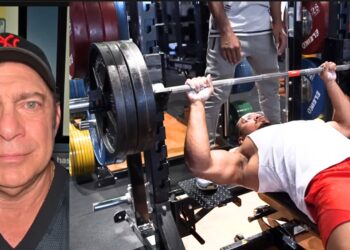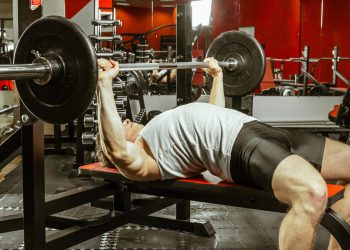Whether you’re a weightlifter trying to set a new bench press personal best or a calisthenics athlete aiming to improve your dipping performance, you need stronger triceps.
The thing about triceps training is that it gets boring quickly. Cable pushdowns, overhead extensions, dumbbell kickbacks, barbell skullcrushers, and close-grip bench presses are the most common triceps training exercises. Performing the same exercises every week can get redundant and lead you to a plateau.
Enter, Tate press.
The Tate press is unlike any other triceps exercise. Doing the move for the first time might feel uncomfortable. It’s primarily because of the exercise’s unique movement trajectory. Investing time and effort in mastering the Tate press will leave you with sleeve-ripping pythons and increased strength.
Triceps is a large muscle on the back of the upper arms and consists of three heads — long, lateral, and medial. Improved triceps strength can lead to better pressing performance in exercises like bench presses, military presses, push-ups, and functional activities like pushing your car, furniture, or a stroller.
This article covers everything you need to know to perfect the Tate press, including a brief overview of the exercise, the muscles worked, benefits, common mistakes, and how to perform the exercise to get the most out of it. Furthermore, we have also included Tate press variations and alternatives to improve the range of your pressing workouts.
Level Up Your Fitness: Join our 💪 strong community in Fitness Volt Newsletter. Get daily inspiration, expert-backed workouts, nutrition tips, the latest in strength sports, and the support you need to reach your goals. Subscribe for free!
What is Tate Press?

The dumbbell Tate press is a dumbbell triceps extension variation that helps build bigger and stronger triceps. The exercise is the namesake of elite powerlifter Dave Tate, who invented the exercise in the 1990s to improve his bench press.
Tate created the exercise as he was experiencing elbow pain from doing traditional triceps exercises such as skull crushers and triceps extensions. The Tate Press’s movement trajectory allowed him to build bigger and stronger triceps without overloading his joints.
Elbow pain due to overuse and using heavy loads can hamper your performance on the bench press and accessory lifts. The inward-collapsing movement of the Tate press gets you the same benefits as the conventional triceps exercises without hurting your elbows.
The Tate press involves lying supine on a flat bench while holding a dumbbell with a pronated grip in each hand. You must then extend your arms straight, so they are perpendicular to the floor. Slowly lower the dumbbells to your chest by bending your elbows.
The Tate press requires you to perform the exercise with a slow, controlled, and deliberate rep tempo. You’ll use lighter weights on this exercise than the dumbbell skull crusher. Performing the Tate press with the correct form needs practice as it involves an unfamiliar movement pattern and requires coordination.
Muscles Worked During Tate Press
Here are the muscles used while performing the Tate press:
Triceps
The Tate press is an isolation (single-joint) exercise that targets the triceps brachii, a horseshoe-resembling muscle at the back of your upper arm. Elbow extension is the triceps’ primary function.
Since the Tate press is a strict movement that requires you to only move at your elbows, you’ll primarily feel the tension in your tris during the lift. Adding the Tate press to your exercise arsenal can help improve your lockout during pushing movements by improving your strength. Plus, it can help induce hypertrophy in the medial and long triceps heads.
The long head makes up a big part of your triceps. However, only a few exercises effectively target the stubborn muscle group. The Tate press is one such exercise.
Secondary Muscles
The secondary muscle groups help stabilize the lift. You must brace your chest, shoulders, and core to maintain a solid base while performing the Tate press. Instability and lack of control during the lift are signs of going too heavy, which can hamper results.
Benefits of Tate Press
Adding the Tate press to your training regimen entails the following advantages:
Builds Muscle Mass
The Tate press is popular among bodybuilders. The isolation exercise stimulates the target muscles by hitting the muscles from a unique angle. Stay in the 8-12 rep range to ignite muscle growth. [1]
Use an appropriate weight that enables a full range of motion and allows you to follow the correct form. Going heavier than you can handle reduces the effectiveness of the exercise and puts you at a higher risk of injury.
Improves Pressing Strength
Dave Tate developed this accessory exercise to help him build lockout strength on pressing movements without overstressing his elbows. Go heavy on the Tate press and perform 5-8 reps if your goal is to build lockout strength that carries over to functional lifts, such as the bench press and military press.
Although the goal of the exercise is to build lockout strength, you shouldn’t go overboard with the weight. This is an accessory lift — treat it like one.
Does Not Overload the Joints
The Tate press was designed for lifters who experience elbow pain in conventional triceps exercises, such as the skull crusher and overhead triceps extension. The unique movement pattern of the Tate press does not overwhelm your elbows during the exercise. It is an excellent lift for people with elbow pain or those undergoing rehabilitation.
Versatility
The Tate press is a versatile exercise. You could perform the triceps extensions on one side at a time to better target the horseshoe muscle. Unilateral exercises are great for fixing muscle and strength imbalances. You could also perform the Tate press on an incline or decline bench to target your tris from different angles.
Improves Coordination
To perform the Tate press, you need to bring the dumbbells to your chest by bending at your elbows. Balancing two dumbbells while moving your elbows requires hand-eye coordination.
How To Do a Tate Press
Below is how to perform the Tate press with the correct form:
Steps:
- Lie supine on a flat bench and place your feet flat on the floor.
- Hold a dumbbell in each hand with a neutral grip (palms facing inward) and place them on your chest.
- Brace your core and extend your arms so they are perpendicular to the floor. Turn your arms, so your palms are facing forward.
- The inside plates of the dumbbell should be touching each other. Your elbows should be pointing outward. This will be your starting position.
- Initiate the movement by bending at your elbows and bringing the dumbbell inner plates toward your chest.
- The dumbbells should touch each other during the eccentric (lowering) motion.
- Touch the dumbbell to your chest at the bottom.
- Return to the starting position.
- Pause and contract your triceps at the top.
- Repeat for recommended reps.
Tate Press Tips:
- Avoid arching your back while performing the Tate press. Keep a neutral spine to avoid unnecessary stress on your lower back.
- The dumbbells should be touching each other throughout the exercise.
- Slow down the rep tempo if you have difficulty establishing a mind-muscle connection or achieving a muscle pump.
- Avoid rounding your back or lifting your chest to achieve better muscle stimulation. Maintain a flat back and keep your shoulders pulled back throughout the exercise.
- Think about driving your elbow pits towards each other during the concentric (upward) motion for better triceps activation.
- Ensure that you are not bending your wrists during the exercise, as it can sprain your joints. Use wrist wraps to lower the risk of injury.
Common Mistakes While Performing a Tate Press
Here are some frequent mistakes that lifters make while performing the Tate press:
Keeping the Dumbbells Away
Many lifters leave gains on the table while performing the Tate press by holding the dumbbells away from each other. Pressing the dumbbells together throughout the range of motion can result in better triceps engagement. The dumbbells should be touching each other for the entirety of the set.
Not Following a Full Range of Motion
Using a restricted range of motion delivers suboptimal results. The dumbbells should touch your chest at the bottom, and you should extend your arms straight at the top for optimal muscle fiber recruitment.
Level Up Your Fitness: Join our 💪 strong community in Fitness Volt Newsletter. Get daily inspiration, expert-backed workouts, nutrition tips, the latest in strength sports, and the support you need to reach your goals. Subscribe for free!
Furthermore, some exercisers turn the dumbbells partially during the eccentric (lowering) motion. You, too, are guilty of this if only your lower dumbbell plates are in contact when the dumbbells make contact with your chest.
Rushing Through the Reps
You must follow a slow and controlled rep tempo to make the most of the Tate press. Rushing through your reps will remove tension from your triceps and put in your elbows and shoulder rotator cuffs.
Driving The Movement Through Your Shoulders
Focus on pressing the dumbbells together while performing this exercise. Lowering and raising the dumbbells by moving your shoulders reduces tension in your triceps.
Instability
Going too heavy on the Tate press can result in instability and cause your arms to shake. Brace your core, glutes, and lower back to ensure a stable base while performing this exercise. Using more weights than you can handle can increase your odds of injury.
Variations and Alternatives of Tate Press
Add these exercises to your training regimen for variety:
Incline Tate Press
The incline Tate Press targets your triceps from a different angle than the conventional variation.
Steps:
- Adjust the incline bench, so the back pad is at a 45-degree angle with the floor.
- Place your back flat against the pad.
- Extend your arms straight, so they are perpendicular to the floor while holding a dumbbell in each hand.
- Your palms should be facing forward, and the dumbbells should touch each other.
- Lower the dumbbell to your chest by turning the dumbbells inward and bending your elbows.
- Return to the starting position.
- Pause and contract your tris at the top.
- Repeat for recommended reps.
Pro Tip: You could also try the decline Tate press as you gain more experience.
Resistance Band Tate Press
The resistance band Tate press is an incredibly effective exercise for people dealing with bad elbows.
Steps:
- Wrap a resistance band around the back of a flat bench at your neck level.
- Lie supine on the bench and plant your feet on the floor.
- Grab the end of the resistance band in each hand.
- The knuckles of both your hands should be touching each other over your chest at the starting position.
- Extend your arms straight. Your thumbs should be touching each other at the top.
- Slowly return to the starting position.
- Repeat for reps.
Pro Tip: Slow down the eccentric (lowering) part of the lift to achieve optimal triceps engagement.
Skull Crusher
The skull crusher is an excellent triceps exercise for folks not dealing with elbow issues.
Steps:
- Lie supine on a flat bench.
- Hold a barbell at shoulder-width with a pronated grip with your arms extended perpendicular to the floor.
- While keeping your elbows pinned, slowly lower the bar until it is about an inch from your forehead.
- Return to the starting position.
Pro Tip: Keep your upper arms parallel to each other throughout the lift. Flaring your elbows removes tension from the target muscles.
Check out our complete skull crusher guide here!
Overhead Dumbbell Extension
The overhand dumbbell extension is one of the best exercises to target your medial and long triceps heads.
Steps:
- Sit upright on a flat bench.
- Lift a dumbbell above your head while holding it by its top plate.
- Keeping your elbows pinned, lower the dumbbell toward the floor behind your head until your lower arms break parallel with the floor.
- Return to the starting position.
- Repeat for recommended reps.
Pro Tip: Keeping your core braced throughout the lift will improve the stability of this lift.
Check out our complete overhead dumbbell extension guide here!
Close-Grip Bench Press
This compound movement helps build bigger and stronger muscles and can improve your stability by working your chest, back, shoulders, and core.
Steps:
- Lie supine on the bench.
- Grab the barbell with a narrow-than-shoulder-width grip.
- Unrack the bar and hold it above your chest.
- Lower the bar toward your chest by unlocking your elbows.
- The bar should touch your chest at the bottom.
- Explode back to the starting position.
Pro Tip: Keep your elbows close to your sides to ensure optimal triceps engagement.
Check out our complete close-grip bench press guide here!
JM Press
The JM press is an advanced close-grip bench press variation. It is a skull crusher and close-grip bench press hybrid.
Steps:
- Lie supine on the bench.
- Grab the bar at shoulder-width using a pronated grip.
- Extend your arms. The bar should be above your neck.
- Lower the bar toward your chin by bending your elbows. Keep your elbows close to your sides during the eccentric motion.
- Explode to the start position.
Pro Tip: Contract your arms throughout the range of motion to fire up your tris.
Check out our complete JM press guide here!
Triceps Pushdown
The cable triceps pushdown keeps constant tension on your tris during the vertical pressing-down movement.
Steps:
- Adjust a cable pulley to its highest setting and attach a straight bar.
- Stand at roughly an arm’s distance from the pulley while facing it.
- Grab the bar with an overhand grip and lean forward slightly.
- Initiate the movement by extending the elbows.
- Press the handle until your elbows are almost locked out.
- Pause and contract your tris.
- Return to the starting position.
Pro Tip: Pull your shoulders back and down while doing this exercise for optimal triceps stimulation.
Check out our complete triceps pushdown guide here!
FAQs
Is the Tate press more effective than the skull crusher?
There is no scientific evidence to prove the superiority of one of these exercises. The Tate press is more joint-friendly. Lifters dealing with elbow issues who want to grow their bench press and build bigger and stronger triceps should prefer the Tate press over the skull crusher.
Is there no risk of injury while performing the Tate press?
All resistance exercises can cause an injury. Use an appropriate weight and the correct exercise form to lower your risk of injury.
Doing the Tate press hurts my elbows. What should I do?
The Tate press is easier on the joints than the conventional triceps exercises like the skull crusher and overhead extension. You must analyze your form if you are uncomfortable while doing the exercise. Try lowering the weights. Avoid this exercise if the discomfort refuses to subside.
Wrapping Up
The Tate press trains your triceps using a unique range of motion. This exercise can help you build bigger and stronger triceps, improving your performance on pressing movements that demand significant triceps strength at lockout.
You must perform the exercise with the perfect form to get the most out of this exercise and reduce the risk of injury. Use the alternatives and variations mentioned in this article to make your workouts interesting. Best of luck!
References
- Krzysztofik M, Wilk M, Wojdała G, Gołaś A. Maximizing Muscle Hypertrophy: A Systematic Review of Advanced Resistance Training Techniques and Methods. Int J Environ Res Public Health. 2019 Dec 4;16(24):4897. doi: 10.3390/ijerph16244897. PMID: 31817252; PMCID: PMC6950543.
Interested in measuring your progress? Check out our strength standards for Bench Press, Push Ups, Tricep Extension, and more.








